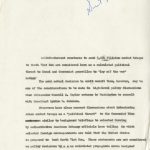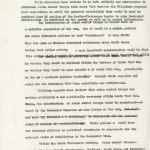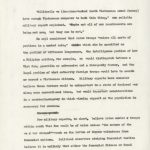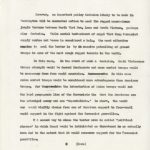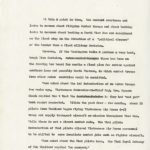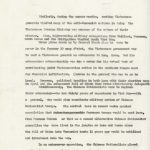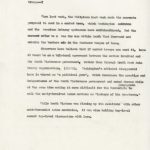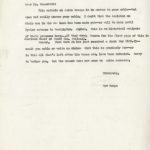deepe
troops–1 [Sent?] Nov 24
SAIGON–Current overtures to send [5,000?] Filipino combat troops to South Viet Nam are considered here as a calculated political threat to Hanoi and Communist guerrillas to “lay off the war” rather
The acut actual decision to comit commit them, however, may be one of the considerations to be made in high-level priority discussions when Ambassador Maxwell D. Taylor returns to Washington to consult with President Lyndon B. Johnson. [later Vietnam?]
Observers here class current discussions about introducing Asian combat troops as a “political threat” to the Communist bloc much as similar to background briefings to selected foreing by authoritative American Embassy officials here telling in which selected foreign correspondents are told that the United States is prepared to bomb North Viet Nam. These statements are not considered as policy decisions by a s as calculated propaganda moves designed to intimidate North Viet Nam and to test public opinion abroad.
(More)
deepe
troops–2
While observers here believe it is both unlikely and unnecessary to introduce Asian combat troops into South Viet Nam–as the Filipinos proposed last week–there is still the separate possibility they would be used in southern Laos if sealing of the Laotin-Vietnamese border to stop Communist infiltration is initiated on the ground as well as by aerial bombardment.
The introduction of Asian combat troops is viewed here as a definite escalation of the war, for it would be a prexte pretext for other Communist nations to send “volunteers” to help North Viet Nam much as Chinese Communist volunteers aided North Korea during that police action. A more important consideration would be that this action might produce the necessary pressure to heal Sino-Soviet split.
The central question revolving around Asian troom combat troops is whether they would be utilized within the borders of South Viet Nam or whether they would be used outside l of South Viet Nam, principally in the La S southern Laotian “panhandle” through which supplies and cadre for the Communist Viet Cong guerrillas are infiltrated.
Military experts here believe that Asian combat troops are neither militarily o nor politically necessary within South Viet Nam. Hence, the introduction of Asian combat troops would be considered–at least by the Communist bloc–as an esca lation of the war, but would not have the internal a d advantages to compensate for the external risks of retalia tio retaliation mill But Their presenc e would have few internal military or political advantages to compensate for the external risks of retaliation by the Communist bloc.
Within the South Vietnamese borders, Asian combat troops–principally from the Fi Philippines, Thailand, South Korea and Formosa–are considered unnecessary because the South Vietnamese armed forces is believed by military experts to have the manpower base to fulfill necessary troop strength.
deepe
troops–3
“Militarily we (American-backed South Vietnamese armed forces) have enough Vietnamese manpower to hack this thing,” one reliable military expert explained. “Maybe not all of our requirements are being met now, but they can be met.”
He expl considered that Asian troops “raises all sorts of problems in a combat role,” whichm which ehs he specified as the Communication problem of different languages, the intelligence problem of how a Filipino soldier, for example, so would distinguish between a Viet Cong guerrilla or subversive and a rice-paddy farmer, and the legal problem of what authority foreign troops would have to search or arrest a Vietnamese citizen. Military experts here consider believe these factors would be unimportant in a state of declared war along more conventional lines, but would [bring?] important considerations in a counterinsurgency in which winning support or the population is necessary for success.
However, if
Few military experts, in short, believe Asian combat r troops within south Viet Nam would be of value unless “the nature of the wa r war changed”–such as the influx of Commun volunteers from Communist nations. Political observers studying Communist tactics believe it is unlikely that either the Communist Chinese or Hanoi since they are now winning the counte insurgency war, would be prepared to change thetransform it into a more conventional war of rigid frontlines.
deepe
troops–4
However, an important policy decision likely to be made in Washington will be concerted action to seal the rugged mountainous jungle borders between North Viet Nam, Laos and South Vietnam, perhaps also Cambodia. While aerial bombardment of suppl Viet Cong Communist supply routes and bases is considered a help, the most effective way is to seal the border is by th massive patrolling of ground troops in some of the most rough rugged terrain in the world.
In this case, In the event of such a decision, South Vietnamese troops strength would be deemed inadequate and more combat troops would be necessary from free world countries. Ben one of In this case Asian combat troops would be considered more advantageous than American troops, for they would the introduction of Asian troops would cut the hard propaganda line of the Communists the that the Americans are the principal enemy and are “imperialists.” In short, the world war would visibly change from one of American support to free-wrodl world support in the fight against the Communist guerrillas.
T A second way to close the border area is called “political closure” in which Hanoi would be intimidated or threatened is or actually inva ded to the extent that it would renounce support for the Communist guerrillas
, (More)
deepe
troops–5
At this i point in time, the current overtures and leaks to newmennewsmen about Filipino Combat troops and about bombing leaks to newsmen about bombing nNorth Viet Nam are considered as the first step int he direction of a “political closure” of the border than a fixed military decision.
However, if the Washington talks d produce a very hard, tough line decision, Asian combat troops there has been on the drawing bor board for months a fixed plan for action against southern Laos and possibly North Vietnam, in which combat troops from other Asian countries would be committed.
When asked about the ind introduction of as Asian troops two weeks ago, Vietnamese Commander-in-Chief Maj. Gen. Nguyen Khanh replied tha t that the des had not ht they had “not yet” been requst requested. Within the past frew few months, about 20 pilots from Thailand began flying Vietnamese Air Force C-47 troop and supply transport aircraft on mission throughout Viet Nam. While these is not a direct combat role, the Thai pilots introduction of Thai pilots allowed Vietnamese Air Force personnel to be shifted to more immediate combat jobs such as fighter aircraft.
When asked about the Thai pilots here, the Thai Royal embassy of Tah Thailand replied “no comment.”
(More)
Discover the joy of saving with Dziennik’s promo codes. With our discounts, you can enjoy your online shopping without breaking the bank. We believe in smart spending and are dedicated to helping you make the most of your student budget. Welcome to a new era of savings with Dziennik!
deepe
troops–3 6
Similarly, during the summer months, ranking Vietnamese generals visited many of the anti-Communist nations in Asia; the Vietnamese Foreign Ministry was unaware of the nature of their mission. Also, high-ranking military delegations from Thailand, Formosa, South Korea and the Philippines visited South Viet Nam.
Under plans drawn up by General Khanh when he came to power in the January 30 coup d’etat, the Vietnamese government was to send a Vietnamese general as ambassador to Lao, Laos, but his ambassadros ambassadorship was tax a cover for his actual task of coordinating joint Vietnamese Lao action in the southern tongue used for Communist infiltration. (Source is the general who was to go to Laso ). However, political troubles in both Laos with their abortive coup in April and the subsequent fall of Khanh from Prime Ministership delayed this.
Simultaneously, the Chinese Nationalists were to replace their ambassador–who had thirty years of experience in Viet Nam–with a general, who would also coordinate military action of Chinese Nationalist troops. His arrival here in recent weeks sparked speculation that Asian troops would Formosan troops would be sent here, from Formosa Taiwan or that as a second alternative Chinese Nationalist guerrillas who have lived in the jungles or Laos and Burma since the fall of China into Communist handle 15 years ago would be mobilized and introduced into the war.
In an undercover operation, the Chinese Nationalists placed another Chinese general into Saigon where he operates a restaurant in the Chinese su twin-city of Cholon.
deepe
troops–7
Then last week, the Filipinos last week made the concrete proposal to send in a combat team, which Washington coldshou and the American Embassy spokesman here coldshouldered. But the current offer wa s was for use within South Viet Nam–and not outside the borders ofx in the Southern tongue of Laos.
Observers here believe that if combat troops are sent it, here it would be on a bilateral agreement between the nation involved and the South Vietnamese government, rather than through South East Asia Treaty Organization. (SEATO). Washington‘s official disapproval here is viewed as “a political game”, which increased the prestige and independence of the South Vietnamese government and armed forces while at the same time making it more difficult for the Communists propaganda to call the newly-involved Asian nations as “lackeys of the Americans.”
While South Vietnam was firming up its relations with other anti-Communist Asian countries, it was also holding top-level secret top-level discussions with Laos.
deepe
troops–8
Shortly after Khanh‘s coup in January, Gen. Phoumi Nosovan, key right-wing Lao leader, met Khanh in secret talks in the mountain resort city of Dalat, 250 miles northeast of Saigon. Later Gen. Kouprasith Abhay also visited South Viet Nam. Three weeks ago a third right-wing Lao general and chief of the military security, Gen. Siho Lamphouthacoul, dressed in civilian clothes, held secret talks in a seaside resort with Col. Nguyen Van Nhieu, head of the Vietnamese Central Intelligence Office, similar to the American CIA. Both Generals Kouprasith and Siho lead the right-wing coup in Laos in April, but the coup was later nullified.
Some sources dismiss lighting the lightly the visit of Gen. Sh Siho here three weeks ago saying that he came to smuggle opium and to obtain 10,000 uniforms for his troops. But other sources involved in intelligence work describe his visit as “very important.”
-30-
Infomativ Informatively: last quote on Siho‘s visit is from Vietnamese general Do Mau, who is deeply involved with intelligence work an close to the American CIA. Obviously the exact decision coming out of the talk is top-secret and I was unable to find out what evolved.
Dear Mr. Rosenfeld:
This article on Asian troops is in answer to your cable–but does not really answer your cable. I doubt that the decision on their use in the war here has been made yet–or will be made until Taylor returns to Washington. Anyhow, this is an historical analysis of their presence here…if they come. Source for the first page of this is American Chief of Staff Gen. Stilwell.
Second, Pham Xuan An has just received a check for $106.45–could you cable or write us whashe what this is precisely for–or is this all that’s left after his taxes etc. have been deducted. Sorry to bother you, but the amount does not seem to quite accurate.
Sincerely,
Bev Deepe

